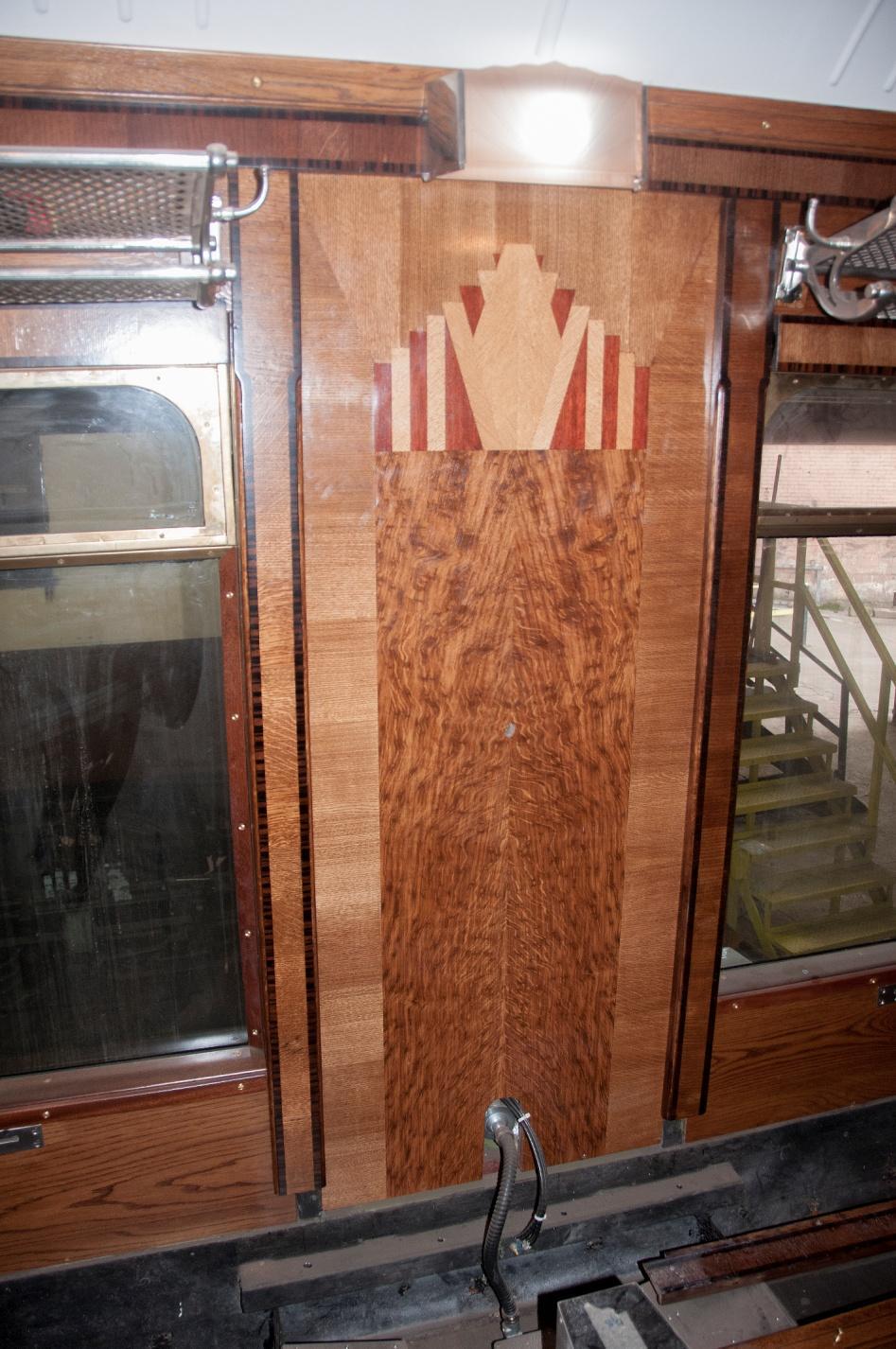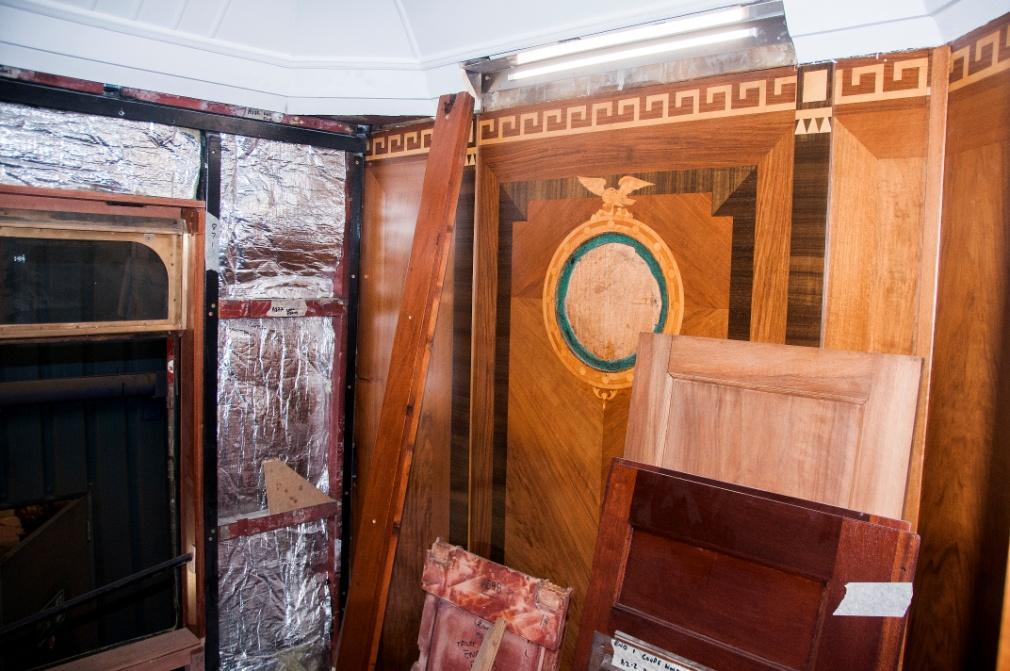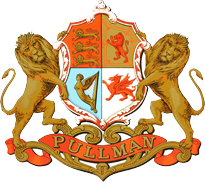BRIGHTON BELLE HISTORY
THE UNIQUE ELECTRIC , ART DECO, PULLMAN MULTIPLE UNIT
FROM THE 1930s

The new train shown on the Quarry Line in the 1930s
The Brighton Belle electric Pullman train was the new Southern Railway’s tour de force, to modernise its stylish but steam hauled Southern Belle Pullman service when the Brighton Main Line was electrified in 1932. Three, five-car, 5BEL unit trains were built by Metropolitan-Cammell and the Birmingham Railway Carriage and Wagon Co, to provide the London (Victoria) to Brighton service with a modern, top-class train, originally as Southern Belle, then Brighton Belle. All cars were furnished in the popular Art Deco style, much loved, and exampled in 1930s streamlined trains and ocean liners. The basic Pullman style remained, but the Brighton Belle was different to all others with individually designed interiors by top-name furnishers like Maples, and Waring and Gillow, together with nickel-plated metalware, Art Deco marquetry, and individual fabrics to Art Deco designs. The overall effect was quite different to earlier Pullman cars, and the train was a favourite from the start, though it was confined to the Brighton Line, with occasional forays elsewhere. Some 23 composite, steel Pullman cars were ordered for the 6PUL and 6CITY multiple unit sets that were built for the new electrified lines, but a full-electric all Pullman train serving Brighton remained unique in the world.
From 1933, when it replaced the steam hauled Southern Belle, the 5BEL sets ran a regular service three times per day, each way (two on Sunday), between London and Brighton. The Brighton Belle was popular, and the service offered drinks, meals and snacks on board that varied over the years. The five-cars were made up of two motor cars and a third-class trailer, with two first class cars in the centre of the train, each with a modest kitchen. The modest kitchen curtailed the range of meals that could be offered, but in any case the train was designed for the one-hour, fifty-mile trip between London and Brighton. This meant that to optimise the business of the time, all three third class cars were arranged in tables of four, and first class was in tables of two, with a four-seater coupé in each first class saloon. The short journey time and restricted space generally kept meals limited to simple affairs. Breakfast was a favourite, especially with kippers.

The Pullman Crest was designed to look like the Royal Arms, and was applied to Brighton Belle from the start. An elongated version was applied in the 1960s with the coming of the Blue Pullmans.
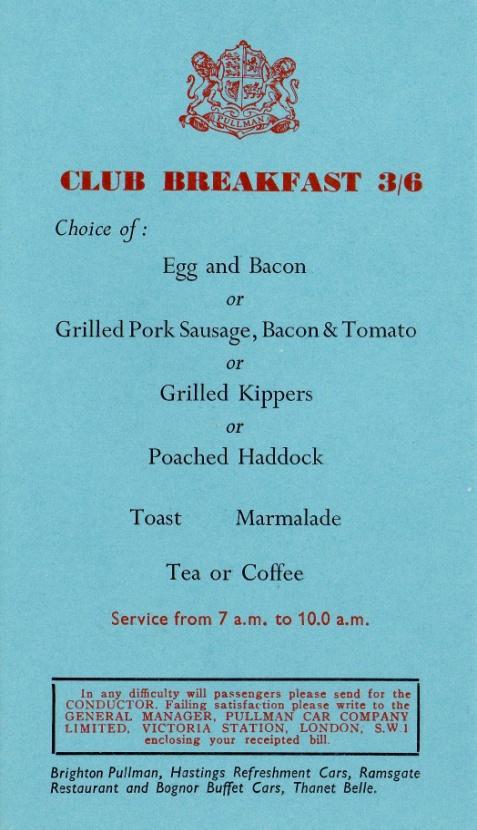
The ‘Brighton Pullman’ breakfast menu in the 1930s.
A motor car in original seating configuration – quite crowded for the 55 minute run from London to Brighton, yet well loved. Not good enough however for longer runs on days out, so radical change has been made – it’s what Pullman would have done!

To satisfy demand, two sets normally ran together as a ten-car train. The third five cars remained spare, used either for charter, or to cover for maintenance. The Pullman Car Company staffed the trains – as they did all their other services – and by charging a supplement they more than paid their expenses. The proposal by Pullman was that the third class of those days was equivalent to first class on lesser trains. The popularity of Pullman services may indeed have proved the point. The third Brighton Belle set was often requested, sometimes as a Royal Train, frequently used to transport visiting heads of state. Otherwise, the Belle ran regularly until the outbreak of WW2 when it was withdrawn.
Towards the end of the War, the train began to reappear in service. It resumed its duty as before, and regained its popularity. Time ticked on until British Rail was facing much criticism on and enveloped all in ‘Corporate Identity’. There was no place for individual and traditional items only for the modern icons. Thus Brighton Belle was painted corporate blue and grey to conform, losing its famous umber and cream livery and individual Art Deco interior decor. By 1970 these trains that had their life extended by the wartime storage were showing their age. Never good riders, they were uncomfortable in comparison with the new designs of train being introduced in quantity, and in 1972 the Brighton Belle was discontinued and withdrawn for scrap.
Its passing was the focus of a great deal of grumbling. Brighton folk were well represented within the great and the good of the theatre world, with Sir Laurence Olivier no less as a regular patron. There had already been a dust up over an underhand attempt to banish kippers, and the corporate British Rail was a national whipping boy. However few could deny that these 1930s trains, with their faded interiors and uncomfortable ride, could continue without radical alteration, and new Pullman trains were not considered an option at the time. Thus in April 1972 the Brighton Belle was withdrawn from service.
Not a single vehicle went for scrap; all found other employment. This was from the heights of the VSOE British Pullman (all first class cars), to rolling along heritage railways behind a steam
engine. No complete unit was saved to run in its own right, and as time ticked by the unsuitability for dining of a 9ft wide Pullman vehicle seating four across slowly expelled the third class cars to the rusty sidings. On-train dining had undergone something of a revolution by the turn of the new century. The Orient Express and the British Pullman had been so efficiently manipulated in the media by James Sherwood and his team, that dining on trains had become a popular occupation. Only one vehicle had been lost, and that was a third saloon. The firsts, all six of them, were highly valued and so employed. The motorcars were not so popular, though VSOE had them in mind as barrier vehicles when crashworthiness was such a serious issue (before
TPWS). Those in sidings were now beginning to rust to the point where the scrappers torch would come soon.
Denis Dunstone, author, man of business and determined supporter of trains of the world, caught the vision of cheating the scrapman, and decided to try to reassemble a 5BEL unit for preservation. He found supporters for the scheme, notably Jeremy Hosking, and he formed a team of people with heritage and professional skills to look at the best way of delivering this aim and make the train self-sustaining. Denis Dunstone reflects that it is sad that electric train preservation has received meagre attention, bearing in mind the massive social contribution electric trains make. The ‘queen’ of electric trains was evidently the Brighton Belle, thus preserving a unit was a popular and good thing to do – and if it wasn’t done ‘now’ then it was likely that vital parts of the train would be lost. A determination appeared, reinforced by urgings that all was possible. Access to a 5BEL preserved would depend on the railway to be chosen. It would inevitably have to be dragged round by an air-braked steam locomotive, or perhaps be push-pulled by a diesel. It would consume resources: finding cover for it, and keeping it in ‘running’ condition, bearing in mind that all its equipment was electrically operated. Careful reasoning declared that the right way to preserve the Belle was the more courageous course of getting it running properly again – and the only way to do this was on the main line.

The lack of space in 2+2 seating can be seen here, when Car 88 was propelled by steam loco Birch Grove along the Bluebell Railway on 5th September 2009 to show people how the project would be conducted, and what was to be done.

Denis Dunstone’s long experience and huge range of contacts encouraged a wide range of supporters for what became a ‘flagship’ project. He is here at Barrow Hill with the late Sir William MacAlpine who loved the idea of restoring the train, and came to see it.
Tales from the privatised railway tended to show that no reasonable, ‘compliant’ offer was refused. This seemed to be opposite thinking to the old British Rail diktats, but early inquiry revealed that, apart from problems with crashworthiness of Mark 1 carriages, heritage trains that could achieve the safety criteria required could run. Even that problem eased when the monocoque system of construction was demonstrated and it was awarded Mk2 status. All seemed clear to plan for a restoration of Brighton Belle to run on third rail lines again, yet the old adage applies in reverse, ‘when one door opens another door closes’. The subsequent experience was not to be a smooth as it looked
like in 2009.
The second obstacle to overcome was the natural wish to preserve the train in its original format. This was impossible, as the cars that were becoming available to work on were not from the same set. Even if this was overlooked, the makeup of the third class vehicles was too cramped for practical catering – snacks perhaps, but splendid meals and Pullman service, certainly not. All the former third class cars had to be converted to 2+1 seating across the vehicle. This had considerable ramifications upon the toilets, which needed to be altered to cater for the ‘offset’. However, it may not have been original, but it was precisely what Pullman did when vehicles were required for longer- distance roles. Yet, even having accomplished the seating change, the two small kitchens installed in the two first class cars were not going to be up to the job of producing the number of quality meals expected – an additional kitchen was required – and this had to be gas operated, so that it could work away from the third rail, in sidings or on non-electrified lines.
The third obstacle was the upgrade of requirements needed to serve ‘today’s’ railway – things had changed radically since 1932; even more so since 1972 when the train was withdrawn. The Brighton Line, for example, was by now a 750V DC powered railway with powerful trains with full electronic traction control and computer-supervised, on-board systems. The objective of faster starting and stopping units is to increase line capacity without less station stops. There was no room for a 70mph, 1932 vintage old-timer to waft a gentle way, disrupting today’s business. So there was no prospect at all of using the original, 1932, traction and braking system: the control gear brought line voltage into the cab; the bogies, that had been changed, still gave a bad ride, which is not good for a dining train. Crashworthiness still had to be improved. Speed needed to be at a maximum of 90mph, with braking to match – even if running at 75mph when dining was contemplated. Modern safety devices had to be fitted. Lastly, the permission for toilet effluent to exit trackside was to cease in 2020; better to deal with this now. Each of these steps meant a healthy ring on the cash register of restoration, and so far, although five vehicles had been obtained, there were two third saloons, with only one first saloon, Doris; not the right formation for a 5BEL unit.

The BR Mk6 motor bogies was chosen and reliability, excellent power and a good ride is expected. Note the lifting shoegear, allowing Brighton Belle to work off the third rail, to be push-pull by a Class 73 or fitted Class 33. This is an extremely flexible train!
The third class cars: 87 (saloon) and 91(motor) came from the North Norfolk Railway with great kindness, as a gift, though they were out on loan to the Keith & Dufftown Railway (surely a distance first for Brighton Belle cars?). VSOE sold motor car 88 and third class car 85 to the 5 BEL Trust after they failed to sell on e-Bay. Doris (first saloon) was a swap for Carina (K Class Golden Arrow car) on the North Yorkshire Moors Railway, giving the Bluebell a loco-hauled vehicle rather that having to convert an ex-electric vehicle. Thus although motley, the 5 BEL Trust, set up to own the cars and organise the restoration, had five cars. A second first saloon was obtained when Hazel, additional restaurant accommodation at a pub in Richmond, Yorks, was purchased for a six-figure sum. This now meant that 6 cars could be made available, to return some seats for those lost by conversion from 2+2 to 2+1 in the third class cars.
In order to meet today’s requirements to return to the main line the following was agreed as works needing to be done:
• The train would be dealt with under an assessment body, where all works must be professionally examined and signed off when compliant.
The BR Mk6 motor bogies was chosen and reliability, excellent power and a good ride is expected. Note the lifting shoegear, allowing Brighton Belle to work off the third rail, to be push-pull by a Class 73 or fitted Class 33. This is an extremely flexible train!
• BR Mk6 motor bogies (2x250hp traction motors per bogie) and B5 bogies for the saloons. A number of ‘scrap’ units were purchased for the purpose as donors – ironic, as it was these that caused the Belle’s demise in 1972!
• The practical way of fitting the recovered bogies was to detach part of the VEP sub frame, including the bogie spigots, and integrate this as a part-underframe, fore and aft under the monocoque body – improving strength considerably.
• Extra strengthening members to be added to the motor car cabs.
• The EP braking system to be transferred, with the air and electrical systems (pumps, motor generator, motor alternator, fuses, resistors, control gear etc.)
• Buckeye couplers to be fitted throughout, with 400 type gangway buffing bars on the front, with OLEO buffers, and drawhook. SR 27-way jumpers and ETS leads to be fitted. Two-tone horn to be roof mounted, new bright lights to be fitted, new pattern windscreen wipers to be fitted. Old indicator box to be refitted, but sealed, together with the front windows. Driver’s doors to be sealed; new exit arranged via the brakevan double-door. Adapted driver’s desk, with new radio and TPWS OTMR, and GSM radio to be installed. New driver’s seats to be installed. Computerised train control system to be installed.
• Sanding gear, retractable shoegear to be installed, push-pull compatible (no wheelslip detection or protection fitted).
The above list was what the new standards demanded, but a massive amount of work has been necessary to install the systems required to make all this work – it has been like building a new train. Herein lies much of the reason for the prolonged rebuilding time, and the steadily expanding bill for it all (to over £1million per vehicle). Not all of these requirements arrived at the same time either. At first the vehicles went to Ramparts at Derby, then to Barrow Hill, where corrosion remedial work and then the massive job of fitting the new bogies was attended to. The four cars of the train to be completed first then moved to more spacious surroundings in the WH Davis facility at Shirebrook. Overall the conversion programme design and Rail Industry compliance is being masterminded by Pindari Ltd, run by Simon Hartshorne, and the work in hand is being directed and managed by KAJ Engineering Ltd, run by Chris Squires.
They have their hands full as this is a demanding, complex and extended project, and smooth and rapid outcomes are hard to earn.

This is a sketch of the intended 174 seat 6 car train, of which an initial 4 cars will be completed: Cars 91, Doris, No. 88 and No.91, offering 109 seats. This will allow the new set 3050 to begin commercial service with the other two cars joining later when they can be funded. The challenge is by no means over!
But engineering standards were no means all; the passengers’ needs have also to be attended to. If the reasoning behind the great increase in spaciousness was fitting the train for quality dining, then the interior restoration has to match the customer aspirations that are being encouraged. The A massive programme of corrosion removal was needed on each Pullman car, where it was sometimes so bad that a lacework of metal was all that remained. New plates needed to be riveted and welded in place to replace those beyond hope, and so restore coherent strength to the vehicles; roofs needed to be repaired and made absolutely watertight. This was a long and costly process – in Doris there was asbestos that had to be removed under protection both expensive and lengthy.
• All of the marquetry (or parquetry if Art Deco geometric shapes) had to be comprehensively overhauled. This was particularly expensive as Car 85’s beautiful sunrise effect had been comprehensively trashed by water ingress over years of unfortunate outside storage: the veneers had discoloured and come away from their bases – it was ‘start again’. Doris had a nasty streak of deep damage, and years of BR ‘care’ meant coat after coat of dull, dark varnish to strip away. Car 88 had lustreless mahogany veneer, scratched and bashed, again dulled by volumes of overpainted varnish. Car 91’s innovative ‘Coffee Pot’ device had less damage, but interior alterations had meant that much work was needed to restore its glory. Having removed all the panels, Wheathills from Derby set to work, stripping, renewing the veneers, and then finishing with a fire-resistant surface that preserved the renewed bright, lustrous effect. Restored varnish suddenly showed remarkable Birds-eye Maple, profound depths and colours in old Mahogany were revealed by cleaning and applying the new surface. The effect is as electric as the train.
• The whole of the exposed Brighton Belle interior metalwork: door handles, hat and luggage racks, table lamps etc, except window frames, was nickel electroplated to a bright, silver finish with a semi-gloss surface, which all looks magnificent, raising the tone from the interiors of the rather austere and dusty Edwardian, traditional Pullmans that ran before. It was entirely the right thing to do, to treat all the metalwork to restore this bright finish, distinct and quite different from gaudy chrome. Any discerning Pullman traveller will recognise that they are on the Brighton Belle.
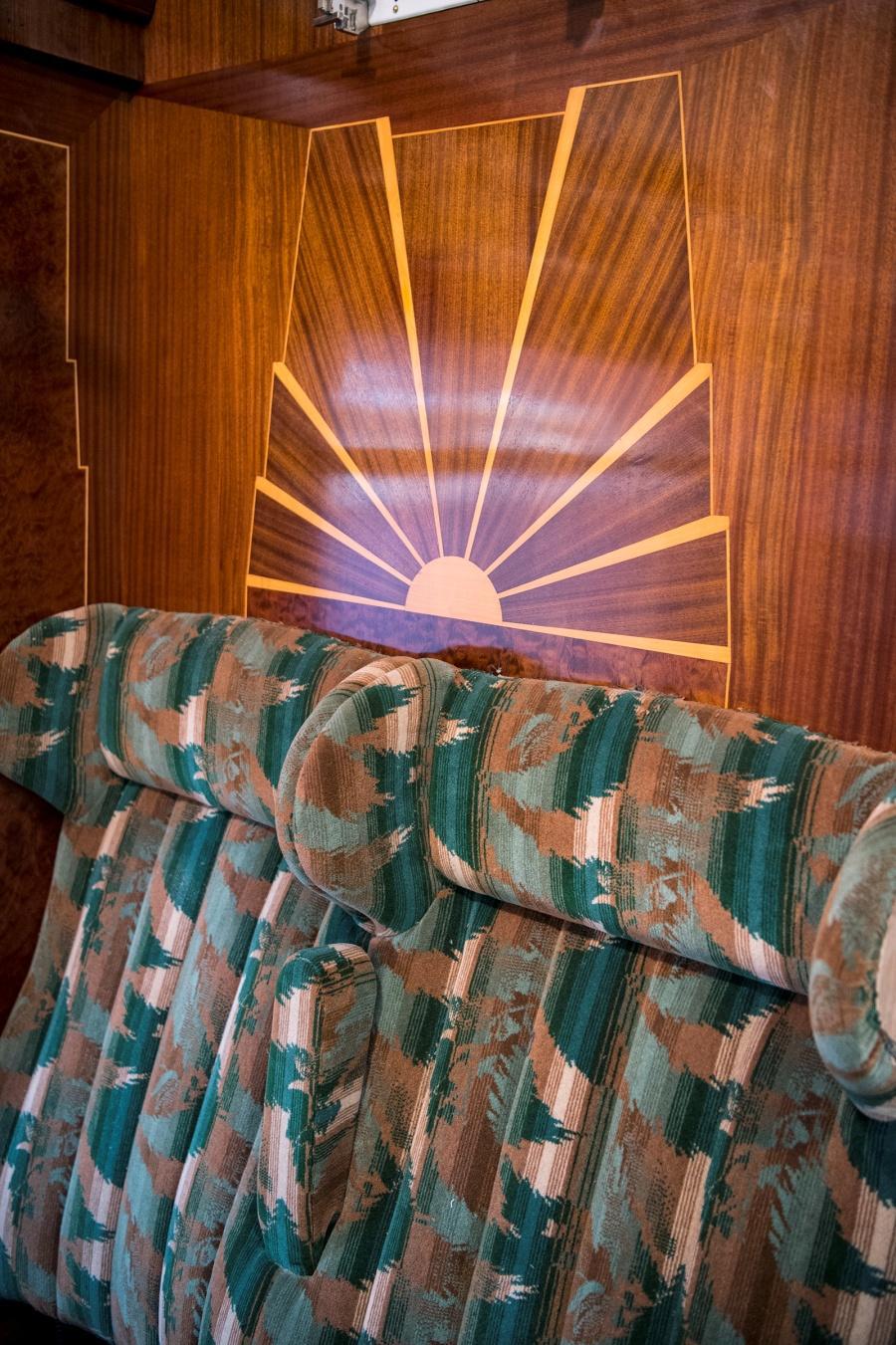
Frank Dumbelton’s picture of the magnificent ‘sunburst’ marquetry, beautifully restored from an awful state, and all complimented by magnificently recreated seating in an original Art Deco fabric: very comfy!
Lighting is an essential part of comfortable ambience. The Southern chose a 70V DC lighting system, and everything was lit by low-output, filament, globe bulbs – still obtainable. However they use surprisingly large amounts of electricity. In today’s world, it is easy to change the supply to suit the affordable, long-lasting, LED globe bulbs. This has been done,
and as LEDs have various colours available, the table lamps have a warm tint, the ceiling lights are brighter and bluer, and the first class car, Doris, has a diffuser over the ceiling LED strip lights – the effect is excellent; the saving in electricity is significant. Most free-standing table lamps had ‘gone alkabout’, thus more were made with great ingenuity and expense, together with new fireproof plastic shades that were at the cutting edge of design in 1932 and are graceful, practical and authentic today.
• All of the crockery, cutlery, glassware and linen has to be obtained new. A design has been created for the train that precisely matches the elegance of the Art Deco period.
The new Brighton Belle brand will be distinctive and is intended to make the train recognisable to differentiate it for the guests on board. The exterior will be in the magnificent and instantly recognisable umber and cream Pullman livery. People so often tell the team of their memories of the humming approach of the train: a streak of brown and cream, with a glimpse of lit, big, square windows, under the legend Pullman, as it passed with a fusillade of wheelbeats on jointed track. We are going to bring that stylish presence back to you.
In order to serve quality meals to all on board, one of the saloons from Car 85 has been fitted with a 19’ kitchen, filled with gas ovens, eyeline grills, fridges sinks, racks and storage. It will be back-to-back with the kitchen in Doris, and the two will work together. The larger, producing main courses, and the smaller specialising in plated food, like starters, desserts, and hot beverages. Gas bottle and water storage (with freezing protection) has been arranged under Car 85 and Doris kitchens to allow preparation of the entire meals on board the train, together with traditional silver service of meals where appropriate.
• Much attention has been given to the bathrooms on board. Pullman traditionally had rather splendid loos, and great efforts have been made to retain the traditional, but to install modern materials. All has had to change, as the former third-class cars have moved the central corridor to an offset position – so a total refit has been needed. At the same time the decision was taken to install a mobility impaired loo – for full wheelchairs – in Car 91, changing its format to bring the compartment to the front for access. In Car 85 the loo has become a cloakroom for staff clothing. In cars 88 and Doris the interior has been refurbished, incorporating original materials, and of course all loos now operate on the retention system.
• When the train was placed in corporate blue and grey, the seating was all standardised into BR colours. The original styles were long gone. Some were almost gaudy; others were ‘restful to the eye’: all were unusual from the 1930s. The fabrics came from Holdsworth, who are still around as Camira, and supply the transport industry. Some kind supporters sent us a sample of a bus fabric that was recognised as a Brighton Belle original. It was easy (if expensive) to get some more, 70 years after its first supply. stuff is not only luxurious, you can run armoured columns of vehicles over it without significant wear. Its only concession to modernity is that it has all the necessary transport fire ratings – and there are more original Brighton Belle designs that may still be ordered for the next two cars! • Summer 2018, without warning, turned into the hottest and longest in recent memory, with frequent warning that this could happen with increasing frequency. The Brighton Belle has large windows with big opening lights to bring in ample air, thus such Pullmans are able to stay cool when moving. However one of the intended futures of the train is delivering people in luxury to spend time at a destination. A train waiting in the sun can become so hot that it is like an oven inside when the guests return to it. Care was taken in exploring for an answer – expensive, power-hungry air conditioning was not accepted as a viable solution. Air-cooling, a relatively inexpensive system that has originated from the boatbuilding industry for private yachts, is to be installed. This creates a stream of cool air in the interior of the cars, with heat removed via bodyside grilles. This method has been chosen to fit to each car, and it will be effective in solving the problems encountered, particularly when the train has to stand on a hot day, waiting for its passengers to return. There is the snag that an unbudgeted spend of £70,000 will be needed. An appeal is currently underway to find donors to help to raise the funds for this.
The train is now reaching the final stages of fitting out. It has been decided to complete 4 cars to begin with, and get those in service as a 112 seat train, and then to introduce the remaining two cars, one with 1+1 armchair seating and the other at 2+1 with luxury seating, as soon as the operation finds its feet. Firstly the train needs to go to be tested and commissioned with Arlington at Eastleigh. This should be in spring 2019. Assuming commissioning is successful, then testing in commercial service is hoped from 2020. The train is planned to be based at Eastleigh and UK Railtours have been chosen to be the booking agent. It is intended to publish the plan to place the train in service in very gentle stages. It has been our experience that placing an electric luxury Pullman train like this back in service over 80 years after its introduction is fraught with uncertainty – and this good reason for making no promises about times and dates. It is far more important to get this celebrated and unique train ‘right’, in its Art Deco glory than to rush it through – and that has been a strategic principle applied throughout.

5BEL Trustee Doug Lindsay stands in the 19’ kitchen he laid out in order to serve top-quality cuisine to the Brighton Belle guests. This kitchen in Car 85, Gravetye Manor, will partner the kitchen in adjacent Car Doris in the centre of the train to offer rapid service of fine meals for up to 170 covers.
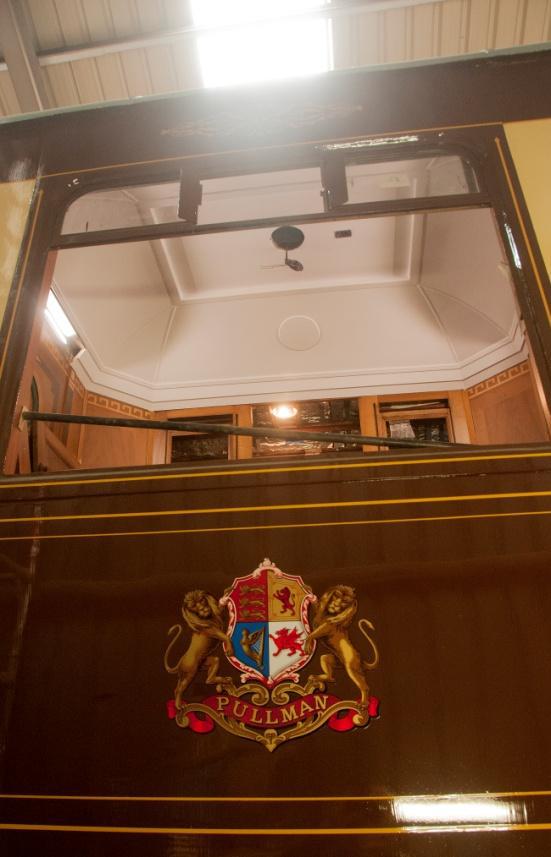
A shot upwards of Doris, showing the coming completion of the 4-seat coupé compartment with the rich exterior paintwork now being applied in traditional style.
We hope that in 2019 the Brighton Belle will emerge on to the third rail once more, firstly to be tested, and accepted for main line running, then in 2020 to enter commercial service, to offer a luxury glide through the beautiful settings of Southern England. It will be immensely flexible, with a superbly comfortable interior, offering fine meals, and interesting days out, but at an upper price tag. The way has been long, hard and expensive, and is open to see it expand to the full 6 car rake as soon as this is practical.
A shot upwards of Doris, showing the coming completion of the 4-seat coupé compartment with the rich exterior paintwork now being applied in traditional style.
The reintroduction of the Brighton Belle will have been achieved by the generosity of donors. It has been one of the most exciting projects in privatisation; a long one, fraught with uncertainty, with difficulty, yet the team and its backers have stuck to their guns, and whilst difficult standards have had to be met, the authorities have maintained an encouraging stance throughout the rebuild, and these standards are the same for everybody. The Rail Industry has shown nothing but encouragement.
We are nearly there; soon there will be much fun to be had!
Right: The design in Car 91 is called Coffee Pot. See the electrical connections for table light and USB charger. The panelling is restored to brightness.
Far Right: The traditional front of Car 88 is being painted in proper Pullman Umber livery. Note the ‘cut out’ route number 4, that could be changed by the driver, but must for safety considerations, now be changed in the depot.
Bottom Right: The stunning interior of the coupé compartment in Doris is having its beautiful panelling restored. This 4-seat haven will be a quiet little place of luxury in which to enjoy a private dinner, whilst the Garden of Kent glides by the window. Note the LED strip above that replaces energy inefficient tungsten filament lights with a better glow.
